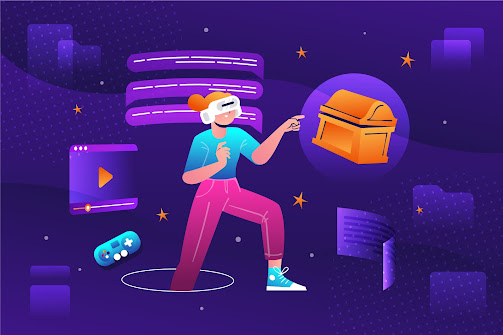Non-fungible tokens (NFTs) have altered the creative business by providing a new way for artists, writers, and innovators to exhibit and monetize their work. Etherization is a one-of-a-kind digital asset that may be confirmed using blockchain technology to ensure ownership and authenticity. This breakthrough enables transparent venues for creators to sell, distribute, and safeguard their work from digital theft. Let's look at how NFTs have become a game-changing force in the creative world, and what the future holds.
Empowering Creativity with Blockchain Technology
Before the introduction of NFTs, the creative world was dominated by galleries, agencies, and publishers, who controlled the flow of art and creativity. However, NFTs have changed this by giving artists access to global platforms to tokenize their work. Whether it's a painting, a song, or a written masterpiece, digital assets give artists complete ownership and control. One of the most notable instances is blockchain games like Etherization in which players own in-game assets as NFTs, emphasizing actual ownership.
With blockchain technology, creators can now interact directly with their audience, sell their artwork on marketplaces, and collect royalties without the need for intermediaries. This new approach to creativity not only allows for financial freedom, but it also ensures that art is available to future generations.
Removal of intermediaries
Previously, artists had to rely on galleries, managers, or record companies to promote their work and negotiate contracts. These intermediaries frequently pocketed large commissions, leaving creators with a small portion of the profit. NFTs provide a decentralized platform that eliminates middlemen, allowing creators to communicate directly with buyers, collectors, and other artists.
For example, with the advent of platforms like as OpenSea, Rarible, and others, artists from all disciplines may now display, sell, and even auction their work to a global audience. This decentralized approach is a game changer for new artists, leveling the playing field and making the market accessible to everybody.
Creators can now use NFTs to negotiate their fees, commission rates, and partnership terms directly. Additionally, blockchain's openness ensures that every transaction is documented, making the entire process more trustworthy and reducing the possibility of unfair practices.
Improving the Image of Sub-communities
NFTs have also helped underrepresented communities and marginalized artists. Previously, many brilliant individuals from subcommunities struggled to obtain resources or opportunities to showcase their art. However, NFTs have broken down these barriers, resulting in a decentralized platform where everyone, regardless of background, can express their talent.
Protection of Art from Digital Theft
Digital art, music, and textual works have always been susceptible to theft, piracy, and unlawful reproduction. Previously, creators struggled to prevent their work from being reproduced or disseminated without permission. However, NFTs provide a solution to this long-standing difficulty. Each NFT is linked to a blockchain record, which provides verifiable proof of ownership and authenticity.
When artists mint their work as NFTs, they ensure that the artwork is encrypted and safeguarded from digital theft. The blockchain's security features make it nearly hard to alter or replicate an NFT without permission, protecting authors' intellectual property and preserving the originality of the artwork.
NFTs for social purposes
NFTs aren't simply about profit; they also provide a unique chance for social good. Artists can sell or auction their works, with the proceeds benefiting charitable or humanitarian purposes. Because NFTs can gain in value over time, their potential to contribute to these causes grows even more.
Artists and producers can donate their work or the revenues from it to assist a variety of causes, including environmental conservation and education. This charitable feature of NFTs enhances their global influence, demonstrating that creativity can also promote real change.
AI Implications in NFTs
The combination of NFTs and AI has led to fascinating new possibilities. Some artists are now utilizing AI to produce dynamic NFTs that change over time. These self-evolving NFTs can adapt and alter, allowing future generations to experience fresh interpretations of the original piece.
For example, AI-generated NFTs can create art, music, or poetry based on specific conditions or interactions. This revolutionary combination of technology and artistry not only improves the collector experience, but it also changes how we see and interact with digital art.
Changing the Game for Audio and Video Art
NFTs have also altered audio and video art. Musicians and filmmakers can now tokenize and disseminate their work via NFT platforms. This has created opportunities for partnerships with artists from other professions to create one-of-a-kind multimedia creations.
Furthermore, the copyright protection provided by NFTs ensures that creators have control over how their work is used. Anyone who want to use or distribute these works must compensate the creator through royalties, resulting in a fair and transparent system for all parties involved.
Future Revenue Opportunities for Artists.
NFTs are poised to further revolutionize the creative industry. As more artists, musicians, writers, and innovators use this technology, the financial prospects will grow. With the increased security of blockchain, the elimination of intermediaries, and the potential to reach a global audience, NFTs provide artists a sustainable and future-proof means to make a living from their art.
Conclusion:
Non-fungible tokens are more than just a technology trend; they symbolize a new era of creation. NFTs provide protection, transparency, and direct access to global marketplaces, allowing artists all over the world to thrive. As the NFT space expands, artists should grab the chance to be a part of this creative revolution.



Comments
Post a Comment